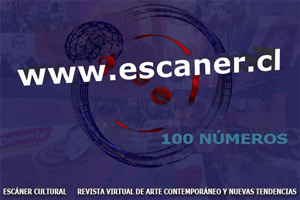By Carolina Lara B.
Autonomous, pluralist and participative: that’s how Chilean magazine, Escaner Cultural, was created in 1999, it was the result of efforts made by an artist (Yto Aranda) who discovered the power of Internet in that time.
Aranda, presently famous in the world of art and technology, wanted to count on an alternative space to shed light on the diversity of authors and works who are usually excluded due to show and consumption criteria. That was how she convinced people around her and artists, writers, art academicians and theorists from different countries in Latin America.
 Twelve years later, some 30 columnists collaborate in the website, by monthly keeping posted a network community. They comment, criticize, spread, organize and share data, activities, critical texts, photographic and audiovisual material on avant-garde practices, contemporary culture and visual arts. The magazine deals with matters such as art and new media, net art, visual poetry, mail art, action art, free culture, cinema, video, social contingency, history, philosophy, poetry, literature, music and theater. With contents for different types of audience, it receives over 3,000 visits on a daily basis and is a benchmark in different areas of the web. However, it receives no funding at all.
Twelve years later, some 30 columnists collaborate in the website, by monthly keeping posted a network community. They comment, criticize, spread, organize and share data, activities, critical texts, photographic and audiovisual material on avant-garde practices, contemporary culture and visual arts. The magazine deals with matters such as art and new media, net art, visual poetry, mail art, action art, free culture, cinema, video, social contingency, history, philosophy, poetry, literature, music and theater. With contents for different types of audience, it receives over 3,000 visits on a daily basis and is a benchmark in different areas of the web. However, it receives no funding at all.
The desktop publishing is the system that has added success to this project, as its director says. Columnists upload their works and they are responsible for the quality and veracity of those works. Author rights are protected by a license of Creative Commons (recognition, non commercial and without derivative work). Text checking is minimal and this relationship is based on confidence. An editorial committee and some basic working guidelines safeguard this procedure, which allows the exercise of personal speeches.
THE EVENT
Between last November and December, Escaner Cultural magazine underwent an intense modernization process. After eleven years of project Fondart 2010 Reestructuracion de Escaner Cultural, Revista Virtual de Arte Contemporaneo y Nuevas Tendencias (Fondart 2010 Restructuration of Cultural Scanner, Virtual Magazine on Contemporary Art and New Trends), its director, Yto Aranda, got technical and visual advances that allowed her to improve web surfing conditions for users.
“We were able to update the platform that manages online contents, acquire our own server, improve the map and architecture of contents, modernize the design of pages, optimize and update the entire website”, as detailed by the people who work with the artist and expert in creative programming, Ítalo Tello.
One of the project’s objectives was keeping a record on its history, a testimony on the contributions made by the first virtual magazine of contemporary art and new trends in Latin America. The Escaner Cultural [12 años] book, 2011, includes pictures, texts written by different authors and unpublished stories that portray this pioneer experience in the sphere of contemporary art and the media.
So the magazine celebrates a new anniversary: after the changes in its design, it’ll launch the publication on May 19 at 19:00 hours, MNBA. The event will reward the audience: the first one hundred people to attend will receive a copy.
Some outstanding national artists related to media arts and experimental video will be joining the celebration: Maria Jose Rios (1973) will invite some spectators to participate as models, by using electronically-made accessories; while Francisco Huichaqueo (1977) will exhibit some of his famous animations, such as “Cadenza” (2005) and “Lo clandestino del paisaje” (2008).
THE STAGE 3.0
For Yto Aranda, these facts set a new moment in the magazine. Stage 3.0: “There was a first period with HTML system and it finished after celebrating the first 90 issues (2007) and implementing the CMS Drupal”, she said. It was a time when it took too long to get the magazine published. During stage 2.0 –she added– columnists were able to desktop publish and the participation of users was increased. “Before Web 2.0, we naturally assumed these changes”, she affirms.
Since 2010, the technical adjustments have allowed the website to gain independence. With its own hosting and a computer programmer who uses Drupal system, the magazine will get dynamism with the idea of facilitating functions for users. Escaner Cultural [12 años] will reach new audiences and it’ll set a testimony beyond cyberspace. “That’s how we enter stage 3.0”, the artist said, playing with this developing idea of a semantic Web (with search systems based on data relations and concept associations), totally interactive and related to artificial intelligence.
The last objective, the director says, is optimizing the magazine: “We aren’t trying to increase our audience, but we’re focused on the specialized sphere and young art schools in Chile. We also want to count on resources that allow shedding light on more artists. We’re interested in a wider testimony of contribution diversity that circulates along with the market system and media companies. The articles remain online and the access is free, so a historical record is created”, concluded Yto Aranda.
LAUNCHING of Escáner Cultural [12 años]: Thursday May 19, 19:00 hours, White Hall at Fine Arts National Museum, Parque Forestal s/n, Santiago de Chile: www.escaner.cl
Related Publications

Catalogue "Smiling and Suffering"
June 03, 2022
Catalogue Flower Power
December 01, 2021











